
Atlas F1 Technical Writer
As the FIA try to reduce performance and cut costs, some radical technical rules will come into play in 2005. Atlas F1's Craig Scarborough analyses the changes and reviews how they are likely to affect the performance of the cars
All the teams run simulation software: this helps the team both predict a set-up for the car over the course of a Grand Prix and also helps predict where development input at the design stage will yield the greatest improvement in laptimes. This latter work on simulation has aided the FIA and the Technical Working Group (TWG) decide on what impact various changes will have on laptimes. Contributions to a laptime were broken into easily quantifiable elements: aerodynamics, tyres and power. By seeing what a 5% gain from any of these would bring, the FIA have found where is it best to cut to reduce laptimes.
From these results the FIA have pinpointed some quite accurate and effective changes, which will see a real reduction in laptimes for 2005, then again in 2006 in order to curb the annual improvements catching up with the initial changes. These rules were not a small revision, but a major slashing of grip both aerodynamically and from the tyres.
In addition, regulations to prolong the life of the engine to two races were brought in to help reduce the rapidly rising power outputs, in addition to this was the mandating of 2.4 litre V8 engines in 2006. Somewhat confusingly these rules could also be seen as having the opposite effect of the FIA's other goals of cost and spectacle. In this article we will detail the changes, the impact they will have the speed of the cars and any impact on costs or the show.
We can split the rules into three sections, bodywork changes, engine changes and strategy changes, plus some simple safety changes.
Bodywork Changes
Instead the teams trade drag to create more aggressive wings that have similar downforce to those that went before, resulting in no major shift in corner or straight line speeds. The ratio of downforce versus drag is known as the lift\drag ratio, or commonly termed aerodynamic efficiency in F1 circles. Recent changes to reduce rear wing elements have seen better designed wings with the same efficiency as the previous multi-element wings, negating the effect of the rule change.
The FIA\TWG have been clever with the new rule changes to cut only downforce and not drag, so consequentially preventing the teams from regaining the lost downforce without major drag implications, this will limit both corner and straight line speed. In achieving this, the FIA have mandated the same size and number of wing elements but placed them in less effective locations. Hence drag is maintained (as the wings are the same size) but downforce is reduced. The front wing has been raised to reduce its interaction with the ground, known as ground effect. The rear wing has been moved forwards where it is disturbed by the flow over the roll structure.
This change will account for a large part of the downforce reduction and leaves the teams with little scope to claw back the losses from the diffuser alone. Compounding this change is a small change to the floor around the rear wheels, which now requires a clearance between floor and rear tyre, preventing the seals and upsetting the airflow to the already crippled diffuser.
Most designers will accept that these changes have cut efficiency by around 25-30%; getting the downforce back will have to involve a drag penalty. The big unanswered question will be how much of it they got back by Melbourne? Everyone is playing their cars close to their chests, no one is willing to release their estimates as the team that have won the most back will be best placed at round 1 in March at Australia.
So how will the new cars look? Several teams already run revised cars with raised front wings, forward placed rear wings and cut down diffusers. The visual effect is subtle with the larger rear wing endplates and greater view of under the front wing. However what the teams will try to regain this lost efficiency will probably appear more dramatic in some cases.
When the current front wing rule was introduced in 2001 some teams ran three-part stepped wings. These placed the lower central span in an ideal space, but the intersection between upper and lower spans upset the flow to the rest of the car, putting unwanted vortices into and taking energy away from the flow over the sidepods to the rear wing. Their trade off for producing the best efficiency at the front was costing at the rear of the car. Another design tried at this time was cascaded front wings, where a third element was added just above the main two elements, this is similar to the design run on the rear wing until recently. But again this has the unwanted effect of sending messy airflow over the rest of the car.
No doubt some teams will try these designs again and may race them at the high downforce tracks, where drag is less important than downforce. Other teams will want to run simpler curved wings maintaining the most homogeneous flow off the front wing, getting this wing to produce the right level of efficient downforce will see several workarounds, adopting the maximum of three elements will allow the wing to be steeper with out leading to drag inducing separation.
The extra space created under the nose\monocoque allows the front wing create its low pressure wake all the way back to the front of the sidepods. This raised nose design also spawned other design details such as keel mounted lower wishbones, bargeboards and sculpted sidepod fronts. Teams have already optimised these areas to quite high levels, so they are restricted in what they can achieve with in the rules. The dimensions of the nose\monocoque area are fixed in length and cross section, as is the cockpit opening. But these two areas are not tied together; it would be possible to create a larger space under the nose\monocoque if the whole nose was raised.
This would have impacts on centre of gravity height and suspension mounting, but provides an area for exploration. Ferrari's Monza test saw a fairing added to the top of the cars nose\monocoque, this could have been the first test of such a design, testing its effect on driver visibility and rear wing performance.
One area that has raised far too much importance from the media is the keel arrangement. Since Sauber, then latterly McLaren and Williams have adopted this format, it has been accepted that twin keel is best for aerodynamics and worst for weight\stiffness. But the aerodynamic gains are smaller than some believe and their adoption is almost certainly a secondary result of the general aerodynamic shape of the car, than a primary design goal to go for single or twin keel. For 2005 don't expect one design to have a huge benefit over the other. How the team works its front wing and bargeboards, in addition to the amount of tuning ballast they prefer to run will decide on twin over single keels.
Most technical directors suggest brake or engine cooling won't be a problem, as the development of new shaped front wing endplates will direct the flow to where it's needed. Bargeboard design and the shape of the front wishbones will need to be subtly altered to make sure the engine cooling flow and flow over the sidepods is controlled.
The rear wing change sees the two upper elements moved forwards while the rear edge of the endplate remains in place. The resulting large endplates are an ugly result, but do not harm the wings effectiveness too greatly. The change will see the rear wing in greater proximity to the untidy flow off the roll structure and further away from interacting with the diffuser, the net result will see a sizable loss in efficiency.
To recoup the losses, teams will need to work harder with the flow straighteners such as the mid and shelf wings that appeared in droves last year. Also as the wing will need to be run at more aggressive angles, detailed work will be required to manage the flow at the wings intersection with the endplate to form smaller vortices keeping drag at a minimum.
One factor adopted by many teams and left largely unchecked by the FIA was the use of flexing wings. BAR were caught out by a protest following on-car footage showing the rear flap flexing at speed. What BAR had done was to allow the flap to deflect under load at high speed, this closed the slot gap and partially stalled the wing, cutting downforce and also drag.
The diffuser is one area where some true innovation will be required to salvage the lost downforce. The outer channels have developed into very three dimension tunnels; with round edged steps between the floor and tunnel, compound curved fences and curved exits. All these shapes are introduced to pull as much air from under the floor as possible and direct it into the larger longer middle tunnel.
For 2005 the outer tunnels must have straight edges, no undercuts and lower exits, now only 125mm tall over the 220mm allowed previously. Teams will lose the tunnel's ability to pull air efficiently from under the car, as a result sidepods may need to be abbreviated to shorten the floor, and the middle tunnel will need to be worked even harder and the shape of the rear wishbones will need to be optimised to interact with the lower outer channels.
All these changes were introduced at the last minute in comparison to the timescales for developing a new car. Teams were already well advanced in the layout of their originally planned 2005 cars. Instead they had to evaluate the new regulations and go back to their wind tunnels and CFD programmes to see the impact of the revised aerodynamics. Most teams have admitted discarding the initial concept for their 2005 cars and redrawing the aerodynamics. This is far from a cost cutting exercise, nor one to equalise the rich and poor in F1, as the well funded teams have plenty of wind tunnel time in hand over the lesser resourced teams.
This leaves the teams in the difficult position of rushing an all-new car out, that is optimised to the new regulations in time for Melbourne, or take more time to understand the problems and race an interim car for the opening races. It seems the majority will plan to race new cars, but final winter testing will need to the see the new car faster than the adapted 2004 chassis.
Engine Changes
Last year saw changes to make engines last a whole race weekend with penalties for engines failing before the race. This was aimed to be a cost cutting exercise. The added development costs needed to make the engines more reliable was undoubtedly greater than the material cost saved in producing fewer engines. Also, any effect on capping performance was ineffectual, most teams claimed they had exceeded their 2003 power outputs by the end of the season, some even declaring their power output at Melbourne was greater than in 2003.
Broadly unpopular with engine manufacturer the rule has been extended for 2005 with engines now needing to last two race weekends, again with penalties for engine failures leading up to the second race. Most of the manufacturers have set to work on the ruling and are less boastful of the impact on power output while retaining reliability. Yet again we can expect to see power outputs drop initially, only to rise and probably exceed those from 2004.
Even before the one-per-weekend rule the teams managed the engines life, in races detuning it to ensure it's reliable to the finish. In 2004 the managing of engine life was carried out over the full weekend, with practice sessions and quiet spells in the race seeing different revs and maps run to ease the load on the engine.
This year the managing will go yet further, it is up to the engine manufacturers to have engines that allow the team to run the engine as fast as it needed over the two weekends. There will be a point where risking running the engine to higher revs late in the first race to gain a place will be offset by the risk of the engine not making it through race two.
Conspiracy theorists will see the teams being left responsible for taking their engines away and bringing them back two weeks later untouched as an opportunity to cheat. The engine manufacturers do not see this as a problem, they are in touch with the FIA and the sensible conclusion will be made on how to police the engines.
Then in 2006 the V10 era will be over, the 3-litre units being usurped by 2.4 litre V8s. This will have a major impact on power outputs and laptimes. From around 900-950bhp by the close of 2005, we can expect nearer 750bhp. While the V8s will share a lot of the internal dimensions of the V10s, these engines will be all new designs owing little in practice to them. Yet more complication and with many undecided details these new engines will be subject to new design rules, with things like fixed bore size, bore spacing, crankshaft height and mounting points.
These limit scope for individuality and development, but also a rule to specify centre of gravity height has drawn criticism from the engine manufacturers. For an engine designer CofG is not a criteria that can be designed in, primarily the engine is designed for performance and the CofG is a secondary concern, it is not a finite figure that must be achieved. How the 155mm CofG height will be measured and enforced is not clear, together with how the designers will go about designing it is also less than clear.
Strategy Changes
The third major element to reduce laptimes is the tyres. When grooved tyres were introduced, the idea was to introduce more circumferential grooves or other tread patterns to restrict grip. Instead the FIA have decided to go with long life tyres. Grooved tyres run relatively soft compounds and are changed frequently in a race in order to maximise grip.
But, the soft rubber soon starts to throw off balls of rubber and creates gripless areas of marbles off the racing line, inhibiting overtaking. To force harder tyres that are less prone to marbles, the FIA will now demand tyres last the whole of second qualifying the entire race, effectively making them last up to four times longer. To prevent teams switching tyres in the qualifying\race period, drive through penalties will be handed out to cars stopping for another set, plus that set will need to be the ones used from first qualifying and not fresh rubber. This extends to tyres with punctures.
Should a car require tyres changing, this cannot be done at the same time as a fuel stop. So no longer will we see cars stopping for tyres in a race. Instead the stark site of the refuellers going to work and no action going on around the wheels will be the "show" the FIA has set out for TV audiences.
At first this prompted the thought of less fuel stops and as a result bigger fuel tanks would be required to go longer between stops in the race. But there is the problem of making the tyres and brakes last. The heavy fuel load tends to wear tyres and brakes faster, so at tracks with big loads on tyre and brakes, lighter fuel loads will still be needed to last the race. Races that tend to have a small penalty on heavy fuel either because of the power characteristics or limited overtaking such as Monza or Monaco may see vastly different strategies for those that can preserve the tyres\brakes.
Added to this fact the qualifying layout will alter this year. Qualifying will still be split into two one-lap sessions, but one run on Saturday afternoon and the other one will be on Sunday morning. The time from the first deciding the order for the second and times aggregated to decide the grid. Again the first session is allowed to run any fuel load and fresh tyres, the second will follow an overnight Parc Ferme procedure and needs to be run on race tyres and fuel loads.
While making the layout of the grid unclear until Sunday morning, little will change in most circumstances. However when conditions are unpredictable, teams will have to assess weather risking a strategically slow first session will repay any gains from running faster in the second session, for example as with Silverstone last year teams ran slow in the first session as the second session was expected to see rain in the latter stages. Also as the two sessions will be run so far apart, if the conditions are very different i.e. one wet - one dry, and then the team must push in both to get the best grid position.
Safety Changes
Other Changes
Two clarifications have been issued to resolve yet more imaginative interpretation of the rules adopted by some teams in 2004.
Renault and other teams have been using various clever control systems to provide a launch control system with in the wording of the 2004 regulation. Teams both use a locking mechanism on the clutch paddle to hold the biting point and the controlled release of the clutch itself. These do not constitute any form of illegal launch control but do not fit in with the spirit of the rules. The FIA have now said the clutch must be under the control of the drivers paddle at all times during the launch phase. Hence the clutch must react to the position of the paddle under the control of the drivers fingertips, not locked into position and the gradually released by hydraulics.
Since gearshifts were mandated to be solely initiated by the driver in the ban on automated shifts for 2004, some teams have again found workarounds to this wording of the rules. This clarification has been widely and incorrectly reported as a restriction on minimum shift time in order to prevent super fast gearshifts, it is in fact the opposite. When a driver is shifting down the gearbox he had to ask for each change in turn, no longer having a button to shift down to a specific gear. So in theory he has to time the downshift to match the engine speed to road speed to stop the rear wheels locking up.
However the gap between the driver asking for the shift (flicking the paddle) and the gear selecting is not specified, teams could have the driver select a lower gear long before the speeds are matched and the electronics will say when the actual shift is completed. This still sees the driver initiating the shift, but not with any degree of control of the actual timing, which is legal but outside of the spirit of the rules. The FIA have asked for a maximum shift time, so that from when the driver initiates the shift to the when the gear is engaged must fit with in that timescale or the driver has to ask for the gear again.
BAR fought the FIA on the legality of the front torque transfer system introduced in Germany and raced in revised form from Monza. BAR dubbed their system Front Clutch Pack (FCP) and in its original form used electro-hydraulics to control the action of the differential between the linked front wheels. This was used not so much as an anti-lock brake system, but a control system to induce a turning effect under braking. Geoff Willis commented at the start of 2004 that corner entry stability was the restriction to a F1 cars speed.
The electronically controlled moog valve upset the other teams and the FIA upheld protests and asked to BAR not run the set-up. When BAR got FIA approval at its appeal to run FCP with out the electronic control, they raced it at Monza in a mechanical mode and lost around half of its improvement in laptime, but it still yielded a gain. As the TWG discussed the systems legality and suitability for F1 it was agreed initially to ban it for 2006, but BAR offered to shelve it for 2004 and not start a pointless race with other teams to develop
Similar systems. Hence the FCP set up will not be seen in 2005.
Team by Team
Ferrari
As has been the case for several years, the season will start with an interim car, while the new car is launched in February and tests away the opening races. Aldo Costa has been the principal designer, with Rory Byrne taking a back seat to his likely successor. While making predictions for any new Ferrari is fraught with errors, the raised chassis option probably won't be as high as the Monza test car if at all. Increasing use of carbon in the gearbox would make an all carbon set up for 2005 a good prediction.
BAR
Unclear if the interim "concept" car will race at Melbourne, BAR have been one of the few teams to run a full 2005 spec test car. Still restricted in the tunnel while their new one is designed, the team should have a good handle on what's required for the new aero rules. A rumour of twin keels was even mentioned, while an even lighter gearbox is expected...
Renault
The first full car from Bob Bell's team will see a greatly revised engine that has had the development time denied to the narrow angle RS23. With an engine on par for power and weight, the team will be diverging from the enforced rear weight biased R24, while the controls departments get to grips with the loss of some of the launch strategies. 2005 could see a very different type of performance from Renault.
Williams
After problems with every part of the chassis and aero on the FW26, the FW27 will have a hole to dig itself out of. With Antonia Terzi split from the team and the new wind tunnel all but ready to produce new parts for the car, changes are expected from the team. It is widely predicted to head away from twin tusk and twin keels concepts, while not trying to go too conservative. The resulting lighter chassis should also mate to a revised BMW engine and a gearbox cured of its problems from 2004. Most likely to race with the new car at Melbourne, the team need to get a car on the pace immediately and with the potential to develop through the season
McLaren
After the MP4-18/19/19B debacle McLaren need to get to a stage where they have a new car ready, reliable and on the pace. Still no news on the new car launch date or their preferred car for Melbourne. The first versions of the 18 and 19 were markedly different from anything else in the pitlane; the 19B brought them back to convention; will the new car head even closer to convention or can Adrian Newey find a new tangent to gain the team an advantage?
Sauber
With the development results of their new tunnel visible on the 2004 car and the new car developed entirely in the new tunnel, Sauber have some promise to deliver on in 2005. While the team are once more designing their own gearbox and heading to Michelin for tyres, they are also establishing their independence despite the purchase of 2005 Ferrari engines.
Red Bull
With a winter of uncertainty, now offset by the Red Bull ownership and only Dr Mark Gillan departing the teams, there is some form of stability at the team. How much the uncertainty and budgets over the winter affected the new car's development remains to be seen. Cosworth equally have had a future in doubt and need to produce a new engine with good power and reliability.
Toyota
First to release their car and the first car under Mike Gascoyne's technical management. The potential of Toyota is increasing, but the car has been admitted to be largely based on the pre-rule change design, so hopefully there aren't too many compromises in this. Yet, Gascoyne tried with some success a similar new car roll out at Renault in 2003, releasing the chassis and mechanicals early, with the aerodynamic update arriving for testing before Australia.
Jordan
With the team's funding still subject to speculation, the design team, with such limited resources, has a huge job to do. Fortunately the supply of Toyota engines and Mark Smith from Renault heading the design team will improve their chances. No news on the car's first test, but without Cosworth engines and no plans to design an interim car for the Toyota engine, we can expect the team to arrive in Melbourne with an all new but little tested car.
Minardi
Having evolved the PS02 over three years, the new rules do not appear to favour another redesign. Whether the team has the resources to design a fresh new car with the pace to keep up with the field is the challenge only Minardi could take on. Expect an interim car to race in Australia.
The FIA often introduce new rules as part of a three pronged goal of improving safety, cutting costs or improving the "show". During the summer and partly as a result of Ralf Schumacher's crash at Indianapolis the FIA made moves to improve safety and this was best achieved by cutting speeds. This speed cutting is only a secondary safety improvement, as in fact the cars are only safer as they are travelling slower. There have been some primary safety changes, but these are quite specific and restricted in their application.
5% power gain = 0.7s laptime gain
5% aerodynamic gain = 0.5s laptime gain
5% tyre improvement = 1.2s laptime gain
 The most visually striking and, in the age of aerodynamics, an effective method to cut laptimes is to reduce aerodynamic grip. Aerodynamic restrictions have been implemented since wings first appeared in F1, but since the flat bottom and later stepped bottom rules for the 80s\90s most changes have been only to cut downforce by making wings smaller. This has the first effect of cutting corner speeds, but the downforce cut has often gone hand in hand with cuts in drag, potentially allowing straight line speeds to rise.
The most visually striking and, in the age of aerodynamics, an effective method to cut laptimes is to reduce aerodynamic grip. Aerodynamic restrictions have been implemented since wings first appeared in F1, but since the flat bottom and later stepped bottom rules for the 80s\90s most changes have been only to cut downforce by making wings smaller. This has the first effect of cutting corner speeds, but the downforce cut has often gone hand in hand with cuts in drag, potentially allowing straight line speeds to rise.
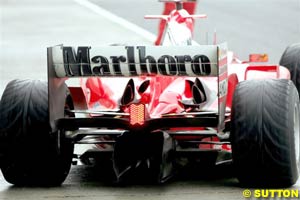 A cars' downforce is produced equally in three areas: front wing, rear wing, and diffuser, yet the drag is produced largely by the wings alone, leaving the diffuser free to make 30% of the downforce for almost no drag. The diffuser has been left untouched by the regulations since the mid nineties and for 2005 has come back in for attention. Now the FIA have restricted its design, enforcing straight edges to the outer channels and limiting their height to almost half of what was allowed previously.
A cars' downforce is produced equally in three areas: front wing, rear wing, and diffuser, yet the drag is produced largely by the wings alone, leaving the diffuser free to make 30% of the downforce for almost no drag. The diffuser has been left untouched by the regulations since the mid nineties and for 2005 has come back in for attention. Now the FIA have restricted its design, enforcing straight edges to the outer channels and limiting their height to almost half of what was allowed previously.
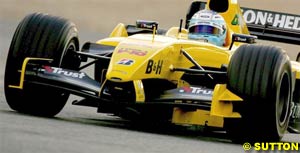 The most influential aerodynamic part on the car is the front wing. This has to be raised 50mm either side of a 500mm centre section. The centre section is allowed to be as low as the floor of the car (as with last year). As the centre section is allowed to be lower it can generate more ground effect and produce more efficient downforce. But tying the raised outer sections to the lower middle span will prove difficult.
The most influential aerodynamic part on the car is the front wing. This has to be raised 50mm either side of a 500mm centre section. The centre section is allowed to be as low as the floor of the car (as with last year). As the centre section is allowed to be lower it can generate more ground effect and produce more efficient downforce. But tying the raised outer sections to the lower middle span will prove difficult.
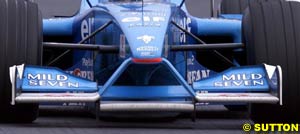 The other criterion for making a front wing work is not just the wings profile itself, but where its immediate wake is formed. One of the results of the 2001 front wing change was the fashion to raise the nose of the car. This didn't mean the tip of the nose cone, but the whole front of the monocoque from the nose all the way back to the driver's hips.
The other criterion for making a front wing work is not just the wings profile itself, but where its immediate wake is formed. One of the results of the 2001 front wing change was the fashion to raise the nose of the car. This didn't mean the tip of the nose cone, but the whole front of the monocoque from the nose all the way back to the driver's hips.
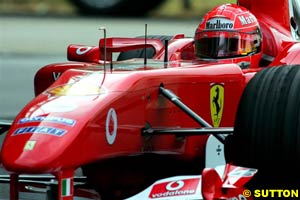 An impact of the front wing being raised is its effect on the flow over the rest of the car; already we have discussed some complex wing designs hampering good flow regimes. Also the higher wing tips see their flow heading straight to where the brake ducts used to sit and the flow under wing will see some dirty air heading into the sidepod inlets and potentially over the top of the sidepods.
An impact of the front wing being raised is its effect on the flow over the rest of the car; already we have discussed some complex wing designs hampering good flow regimes. Also the higher wing tips see their flow heading straight to where the brake ducts used to sit and the flow under wing will see some dirty air heading into the sidepod inlets and potentially over the top of the sidepods.
 At higher speeds where the driver didn't need downforce and hence drag to keep increasing, the stalling effect capped drag and allowed greater straight line speed. BAR were not alone in using flexible aerodynamics, but the protest was upheld and this lead to a revised deflection test for the rear flap. Many teams' front wings also adopted similar approaches with the flap flattening with speed. Agreement between the teams has seen some of these practices dropped for 2005 with potentially new deflection tests introduced to police the problem.
At higher speeds where the driver didn't need downforce and hence drag to keep increasing, the stalling effect capped drag and allowed greater straight line speed. BAR were not alone in using flexible aerodynamics, but the protest was upheld and this lead to a revised deflection test for the rear flap. Many teams' front wings also adopted similar approaches with the flap flattening with speed. Agreement between the teams has seen some of these practices dropped for 2005 with potentially new deflection tests introduced to police the problem.
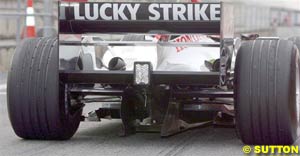 Making matters worse is the enforcement of a gap between the rear tyre and floor; this will send higher pressure air from over the floor, spilling under to towards the diffuser and upsetting its effectiveness. We can expect to see fences and strakes around this area to prevent to the flow going where it's not wanted, fortunately this area is largely unregulated and the teams should find solutions quite easy to come by. The dark black carbon fibre moulding of the diffuser will see some of the greatest unseen development in 2005, as the teams work to recapture the lost drag-free downforce.
Making matters worse is the enforcement of a gap between the rear tyre and floor; this will send higher pressure air from over the floor, spilling under to towards the diffuser and upsetting its effectiveness. We can expect to see fences and strakes around this area to prevent to the flow going where it's not wanted, fortunately this area is largely unregulated and the teams should find solutions quite easy to come by. The dark black carbon fibre moulding of the diffuser will see some of the greatest unseen development in 2005, as the teams work to recapture the lost drag-free downforce.
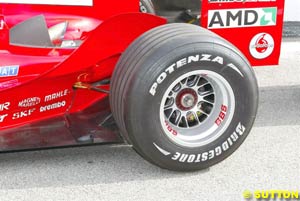 One last question is, will the changes that will cost the teams more, and slow the car actually improve the show? Will any of this improve overtaking? That is doubtful. At only 85mph an F1 car can produce its own weight in downforce, so following another car in corners will still see the second car disadvantaged, braking distances will not be stretched out by more than metre or two and speed differential and slipstreaming on the straights will be at similar levels. So there will be no instant improvement in the show.
One last question is, will the changes that will cost the teams more, and slow the car actually improve the show? Will any of this improve overtaking? That is doubtful. At only 85mph an F1 car can produce its own weight in downforce, so following another car in corners will still see the second car disadvantaged, braking distances will not be stretched out by more than metre or two and speed differential and slipstreaming on the straights will be at similar levels. So there will be no instant improvement in the show.
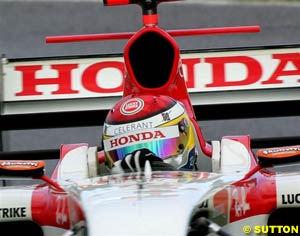 As is common for most new seasons the impact tests have been tightened yet further in 2005. As has the strength of the wheel retaining tethers. To ensure the driver is safe and to restrict imaginative interpretation of the cockpit padding dimensions, the thickness and uniformity of the side impact padding has been increased. Lastly the problem of shards of carbon fibre littering the track after even quite minor incidents has been eased, with the teams expected to wrap the front wing endplates and wishbones in Kevlar skins to contain the debris. All of these rules were agreed unanimously by the teams.
As is common for most new seasons the impact tests have been tightened yet further in 2005. As has the strength of the wheel retaining tethers. To ensure the driver is safe and to restrict imaginative interpretation of the cockpit padding dimensions, the thickness and uniformity of the side impact padding has been increased. Lastly the problem of shards of carbon fibre littering the track after even quite minor incidents has been eased, with the teams expected to wrap the front wing endplates and wishbones in Kevlar skins to contain the debris. All of these rules were agreed unanimously by the teams.
|
Contact the Author Contact the Editor |
Please Contact Us for permission to republish this or any other material from Atlas F1.
|
Volume 11, Issue 1
Articles
Red Cars, Red Ink
2005 Technical Preview
The Fuel Stop Returns
Regular Columns
On the Road
Elsewhere in Racing
The Weekly Grapevine
> Homepage |